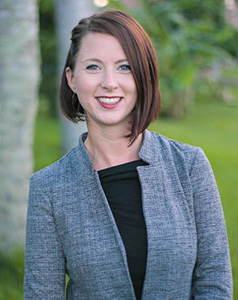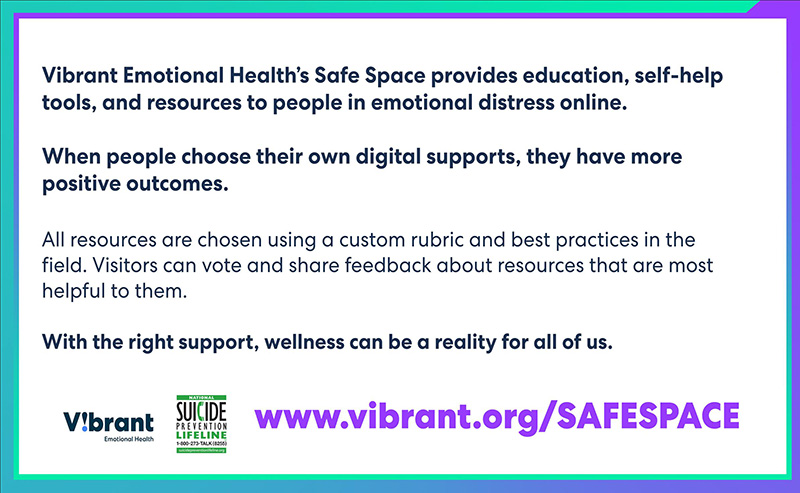The personal impact of being in the helping profession never crossed my mind when I was in graduate school on my way to becoming a social worker. My focus was on gleaning what I could from my professors and building what I hoped would be the most complete set of clinical skills. I was unaware at the time of how much of a toll the work would take on me.

Amy Petersen, LCSW
Secondary traumatic stress is often mentioned as an afterthought and placed as the last item on the agenda if it makes it on at all. When it is discussed, the emphasis is often on individual practices of self-care and personal steps to be taken outside of working hours to avoid burnout. Graduate schools often overlook teaching students about the warning signs of secondary traumatic stress and miss the opportunity to highlight the impact that it can have on individuals, teams, and mental health organizations more broadly. In turn, the field has not yet understood the importance of secondary traumatic stress as a key part of strong clinical training. Yet, in order to foster resilience amongst providers and promote a healthy organizational culture, it is crucial to incorporate a robust discussion of secondary traumatic stress (STS).
Just a few years after entering the field with excitement and optimism, I began to experience what I now know as the signs of STS. I saw these were signs not only in myself but in many of my colleagues and friends across the field. The daily weight of our work in hospitals, shelters, schools, or with survivors of abuse was starting to take its toll in both obvious and subtle ways. And yet, the impact that our line of work was having on us was rarely, if ever, discussed.
As I noticed my own warning signs – hypervigilance, anxiety, a sense of helplessness in the face of patients’ suffering, just to name a few – I saw that my STS took a toll on my interactions with clients and colleagues, my personal relationships, and my own sense of well-being.
Everyone responds differently to STS. It can manifest itself cognitively (e.g. difficulty concentrating, preoccupation with traumatic content), emotionally (outbursts of anger, feelings of hopelessness, numbness), behaviorally (isolation, overactivation), or physiologically (sleep or appetite disruptions, frequent illnesses) (Administration for Children & Families, n.d.).
At an individual level, STS may be easy to spot. Much like a check engine light that signals to the driver of an underlying issue, certain clear signs may allow the person to recognize their own heightened stress. Alternatively, it may be difficult for the impacted person to recognize their own traumatic stress, more like a broken taillight that requires an external party to point out the concern to the driver. They may need a supervisor, friend, or family member to reflect back on their observations of how the person is being visibly impacted by the work.
Though I saw the signs, it took me some time to recognize these as symptomatic of secondary trauma. At first, I wondered what was so wrong with my friends outside of the field for not caring as deeply as I did about suicide prevention, why they did not scan the subway as cautiously as I did for people at risk of jumping onto the tracks, and why they did not feel an overwhelming sense of responsibility for the emotional well-being of their fellow subway riders during their morning commute. It was not until my friends and family highlighted the warning signs to me that I began to realize the degree to which it was impacting my daily life.
I took the steps I needed to recover; however, I could not help but look back and notice how little STS was talked about on the job. While my peers in the field often shared my experience of daily encounters with severe trauma and behavioral health crises, the daily exposure to trauma and suffering was no longer an exceptional event, rather a constant and repetitive one. In turn, our own chronic stress and the weight of patients’ traumas were normal, perhaps even invisible, to us. Though we would eagerly advise our own patients to pause and reflect on their own experiences, needs, and well-being, we were often slow to do the same for ourselves.
Our field has a number of risk factors that make us prone to ignoring the signs and realities of secondary trauma – a preference for helping rather than being helped, tight budgets that make for few margins with our time or finances, and an increased demand for services as mental health needs grow globally. Even if we do stop to acknowledge these risks, we may be slow to take the extra steps to create the changes needed, whether because it demands even more of our time and energy or because we lack a roadmap to guide our changes (Figley, 2002).
While STS affects the individual, it can also have a systemic effect. Ironically, an organization marked by secondary trauma may struggle to deliver quality trauma-informed care. I have observed that teams whose staff are experiencing significant secondary traumatic stress seem prone to groupthink, lapses in judgment, boundary-blurring, overextension, detachment, team conflict, and high staff turnover.
Though the mental health field is not the only field at risk of its workforce developing secondary trauma, it is well-equipped to lead the way on how to respond to STS and be a model for other industries in this area.
The mental health field can start by making discussions of STS a commonplace practice. These discussions benefit not only individual staff, but also foster a trauma-informed and supportive team culture, increase retention of mental health staff in the field, and also ensure that staff are able to provide high quality of care to patients.
Leaders who have a strong understanding of the impact of secondary trauma can incorporate this understanding into their management approach in order to foster resilience amongst individual providers, as well as within their organizational culture. In turn, they will be better equipped to serve their clients, staff, and carry out their organizational mission.
Secondary trauma stress is nearly unavoidable in settings where staff are exposed to extremely heavy work on a daily basis. It is a systemic risk within the field and can stymie organizations’ ability to carry out their mission. Thus, recognizing the strategic importance of tackling STS at an organizational level is crucial to the field of mental health.
Organizational leaders can take steps to encourage self-care practices that have been shown to mitigate the impact of secondary trauma. Physical activity stands out as being particularly helpful in combating these impacts. Mindfulness practices, healthy nutrition, and good sleep hygiene are key elements of good self-care (Figley, 1995). Mental health organizations may find creative ways to incentivize these practices or create space for them in the work week, for instance by reimbursing gym memberships, setting up friendly workplace competitions, or designating a regular physical activity or self-care hour during the week.
Leaders can also take a number of steps to foster increased awareness of secondary traumatic stress. First by developing organizational fluency and regular discussion around STS through staff training, developing shared concepts and terms, and building awareness of telltale signs of secondary trauma.
Managers can also play a significant role by having regular discussions with their staff about STS and help them to identify when they may be impacted. Managers who openly have these discussions and share about their own experiences with STS normalize stress reactions and reduce feelings of isolation and helplessness.
Lastly, leaders can encourage social connection through the creation of buddy systems (Peterson, 2018). Staff can be paired with a peer with whom they have regular conversations about self-care and the impact their work has on them. They can hold each other accountable in recognizing signs of STS and take steps to address each other’s needs.
Today, leaders in the mental health field are looking to strengthen their organizations through trauma-informed approaches. This should include an awareness of STS and how to mitigate it. As the field incorporates intentional practices to counter STS, mental health staff will feel more supported, be more self-aware of their own reactions, and be better equipped to stay in the field longer while providing high quality care.
Amy Petersen, LCSW, is Program Director of Children and Family Treatment and Support Services at Vibrant Emotional Health. She also has a private practice where she works with children and adults across NYC. She can be reached at apetersen@vibrant.org.
References
Administration for Children & Families. (n.d.). Secondary Traumatic Stress. Administration for Children & Families. https://www.acf.hhs.gov/trauma-toolkit/secondary-traumatic-stress.
Peterson, S. (2018). Introduction. The National Child Traumatic Stress Network. https://www.nctsn.org/trauma-informed-care/secondary-traumatic-stress/introduction.
Figley, C. (1995). Compassion fatigue: Coping with secondary traumatic stress disorder in those who treat the traumatized. New York, NY: Brunner-Routledge.
Figley, C. (2002). Compassion fatigue: Psychotherapists’ chronic lack of self-care. Psychotherapy




